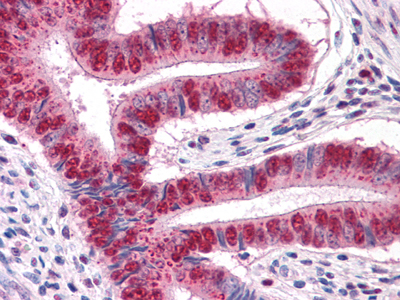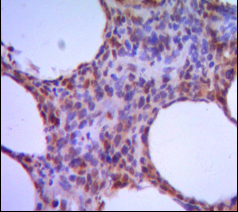Product Detail
Product NameMUM1 Antibody
Clone No.H7-G10
Host SpeciesMouse
ClonalityMonoclonal
PurificationProA affinity purified
ApplicationsWB, IHC
Species ReactivityHu
Immunogen DescRecombinant protein
ConjugateUnconjugated
Other NamesInterferon regulatory factor 4 antibody
IRF 4 antibody
IRF-4 antibody
Irf4 antibody
IRF4_HUMAN antibody
LSIRF antibody
Lymphocyte specific interferon regulatory factor antibody
Lymphocyte specific IRF antibody
Lymphocyte-specific interferon regulatory factor antibody
Multiple myeloma oncogene 1 antibody
MUM 1 antibody
MUM1 antibody
NF EM5 antibody
NF-EM5 antibody
NFEM5 antibody
PU.1 interaction partner antibody
Sfpi1/PU.1 interaction partner antibody
Transcriptional activator PIP antibody
Accession NoSwiss-Prot#:Q15306
Uniprot
Q15306
Gene ID
3662;
Formulation1*TBS (pH7.4), 1%BSA, Preservative: 0.05% Sodium Azide.
StorageStore at -20˚C
Application Details
WB: 1:500-1:1,000
IHC: 1:100-1:200
Western blot analysis of MUM1 on human MUM1 recombinant protein using anti-MUM1 antibody at 1/1,000 dilution.
Immunohistochemical analysis of paraffin-embedded human uterus tissue using anti-MUM1 antibody. Counter stained with hematoxylin.
Immunohistochemical analysis of paraffin-embedded human melanoma tissue using anti-MUM1 antibody. Counter stained with hematoxylin.
Immunohistochemical analysis of paraffin-embedded non-Hodgkin`s lymphoma tissue using anti-MUM1 antibody. Counter stained with hematoxylin.
MUM1 (melanoma associated antigen (mutated) 1) is a 710 amino acid protein that becomes phosphorylated by Atm or ATR upon DNA damage and exists as two alternatively spliced isoforms. The gene encoding MUM1 maps to human chromosome 19, which consists of over 63 million bases, houses approximately 1,400 genes and is recognized for having the greatest gene density of the human chromosomes. It is the genetic home for a number of immunoglobulin (Ig) superfamily members, including the killer cell and leukocyte Ig-like receptors, a number of ICAMs, the CEACAM and PSG family and Fc receptors (FcRs).
If you have published an article using product 48448, please notify us so that we can cite your literature.






 Yes
Yes



